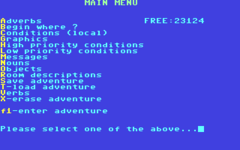| Graphic Adventure Creator | |
|---|---|
 Graphic Adventure Creator for the C64 | |
| Developer(s) | Sean Ellis, Brendan Kelly, Dave Kirby, "The Kid" |
| Publisher(s) | Incentive Software |
| Designer(s) | Sean Ellis |
| Platform(s) | ZX Spectrum, Amstrad CPC, Commodore 64, BBC Micro |
| Release | 1985 |
| Genre(s) | Game creation system, utility |
| Mode(s) | n/a |
Graphic Adventure Creator (often shortened to GAC) is a game creation system/programming language for adventure games published by Incentive Software, originally written on the Amstrad CPC by Sean Ellis,[1] and then ported to other platforms by, amongst others, Brendan Kelly (Spectrum),[2] Dave Kirby (BBC, Electron)[3] and "The Kid" (Malcolm Hellon) (C64).[4] The pictures in the demo adventure, Ransom, were made by Pete James and the box cover art by Pete Carter.
GAC was released in 1985 for the Amstrad CPC[1] and in 1986 for the ZX Spectrum,[5][2] Commodore 64[6][4] and BBC Micro.[3] A simplified version without graphics, called just the Adventure Creator, was also released for the Acorn Electron in 1987.[7] GAC was ported to the Atari ST in 1988 as ST Adventure Creator (STAC) by the original author.[8][9]
GAC had a more advanced parser than The Quill, allowing commands like GET THE LAMP THEN LIGHT IT, and a built-in graphics editor. Over 300 titles were written using GAC.[10] It also came with a built in text compressor.[5]
YouTube Encyclopedic
-
1/3Views:2 12230358 371
-
GAC (The Graphic Adventure Creator) part 1
-
How To Make A Game With Graphic Adventure Creator (Part 1) - GameHammer Extra
-
Adventure Creator: Creating a 2D game Tutorial
Transcription
Reception
GAC was well received, earning a Zzap! Gold Medal Award[6] and a Crash Smash.[11] Your Sinclair reviewed the ZX Spectrum version giving it a 9/10 score.[5] The ST version reached number 18 on the bestsellers chart on August 1988.[9]
References
- ^ a b "the graphic adventure creator © incentive (1985)". www.cpc-power.com. Retrieved 2023-09-10.
- ^ a b "The Graphic Adventure Creator at Spectrum Computing - Sinclair ZX Spectrum games, software and hardware". Spectrum Computing. Retrieved 2023-09-10.
- ^ a b "The Graphic Adventure Creator (BBC Model B) - Everygamegoing.com". www.everygamegoing.com. Retrieved 2023-09-10.
- ^ a b "Graphic Adventure Creator, The". Lemon64. Retrieved 2023-09-10.
- ^ a b c "YS Adventures - Graphic Adventure Creator". Your Sinclair. August 1986. p. 79.
- ^ a b "Graphic Adventure Creator". Zzap!64 (17). Newsfield: 70–71. September 1986. Retrieved 2013-05-29.
- ^ "The Adventure Creator (Acorn Electron) - Everygamegoing.com". www.everygamegoing.com. Retrieved 2023-09-10.
- ^ "The Game Makers - STOS, STAC and TaleSpin Make Game Creation Easy". START. Vol. 4, no. 2. September 1989.
- ^ a b "Atari ST STAC - ST Adventure Creator : scans, dump, download, screenshots, ads, videos, catalog, instructions, roms". www.atarimania.com. Retrieved 2023-09-10.
- ^ Classic Adventure Solution Archive, list of GAC titles.
- ^ https://worldofspectrum.org//pub/sinclair/games-adverts/g/GraphicAdventureCreatorThe_3.jpg
See also
- The Quill, another common text adventure engine
External links
- Graphic Adventure Creator at SpectrumComputing.co.uk
- Graphic Adventure Creator at Lemon 64
- Graphic Adventure Creator at Curlie
